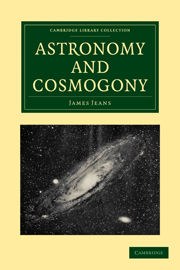Book contents
- Frontmatter
- Contents
- LIST OF ILLUSTRATIONS
- PREFACE
- CHAP. I The Astronomical Survey of the Universe
- CHAP. II The Light from the Stars
- CHAP. III Gaseous Stars
- CHAP. IV The Source of Stellar Energy
- CHAP. V Liquid Stars
- CHAP. VI The Evolution of the Stars
- CHAP. VII Non-spherical Masses–Dynamical Principles
- CHAP. VIII The Configurations of Rotating Liquid Masses
- CHAP. IX The Configurations of Rotating Compressible Masses
- CHAP. X Rotation and Fission of Stars
- CHAP. XI The Evolution of Binary Systems
- CHAP. XII The Ages of the Stars
- CHAP. XIII The Great Nebulae
- CHAP. XIV The Galactic System of Stars
- CHAP. XV Variable Stars
- CHAP. XVI The Solar System
- CHAP. XVII Conclusion
- Index of Subjects
- Index of Names
CHAP. XII - The Ages of the Stars
Published online by Cambridge University Press: 07 September 2010
- Frontmatter
- Contents
- LIST OF ILLUSTRATIONS
- PREFACE
- CHAP. I The Astronomical Survey of the Universe
- CHAP. II The Light from the Stars
- CHAP. III Gaseous Stars
- CHAP. IV The Source of Stellar Energy
- CHAP. V Liquid Stars
- CHAP. VI The Evolution of the Stars
- CHAP. VII Non-spherical Masses–Dynamical Principles
- CHAP. VIII The Configurations of Rotating Liquid Masses
- CHAP. IX The Configurations of Rotating Compressible Masses
- CHAP. X Rotation and Fission of Stars
- CHAP. XI The Evolution of Binary Systems
- CHAP. XII The Ages of the Stars
- CHAP. XIII The Great Nebulae
- CHAP. XIV The Galactic System of Stars
- CHAP. XV Variable Stars
- CHAP. XVI The Solar System
- CHAP. XVII Conclusion
- Index of Subjects
- Index of Names
Summary
The discussion of the last chapter shewed that the orbits of binary stars, both spectroscopic and visual, are still far from conforming to the statistical laws which must finally prevail after the stars have interacted with one another for an unlimited length of time. The same is true of the components of the velocities of the stars in space. After a sufficiently long time of interaction between stars, these ought to conform to the well-known Maxwell law of distribution of velocities. The investigation of Seares already given has shewn that the resultant velocities conform well enough, at least to the extent of obeying the law of equipartition of energy, but the distribution of their directions is far from conforming to this law. After a sufficiently long time of interaction, stellar velocities must be distributed in all directions equally, their motion not favouring any one special direction. As Kapteyn shewed in 1904, the actual velocities of the stars shew a very marked favouritism for a definite direction in space, so that the law of distribution appropriate to the final state is far from being obeyed.
If the statistical laws which specify the final steady state had proved to be exactly obeyed, we could have concluded that the stars had been interacting with one another for a very long time, but we could not have estimated the length of this time except possibly in terms of a lower limit.
- Type
- Chapter
- Information
- Astronomy and Cosmogony , pp. 316 - 330Publisher: Cambridge University PressPrint publication year: 2009First published in: 1928

